Last month we shared some movies that broke the “the book is better, actually” rule. Yes, the adaptation could not exist without the work of the original author(s). However, sometimes things just work better on screen for a variety of technical, personal, or social reasons. That list came from an idea for a much larger and ultimately unwieldy one that included mini-series and TV show adaptations. So here, we’ve decided to share some of the situations where the show was a better time than the book. (With some honorable mentions.)
In an era of prestige television kicked off by HBO and then AMC, it almost feels like the books have some disadvantages. A show can expand upon our favorite characters and plots. Like movies, they benefit from hindsight and more writers’ backgrounds influencing the story. Many of these elements can backfire, too. For example, TV yields a higher likelihood of unwarranted filler. Additionally, it is difficult to cast better characters than our imagination, where budgets and time are unlimited.
Art is personal and political so you won’t agree with all the entries. While less contentious than last time, this is another situation where the Mary Sue writers who came together on this list didn’t agree either. Still, this was a lot of fun to write, and we can’t wait to see your suggestions after reading this list.
Normal People
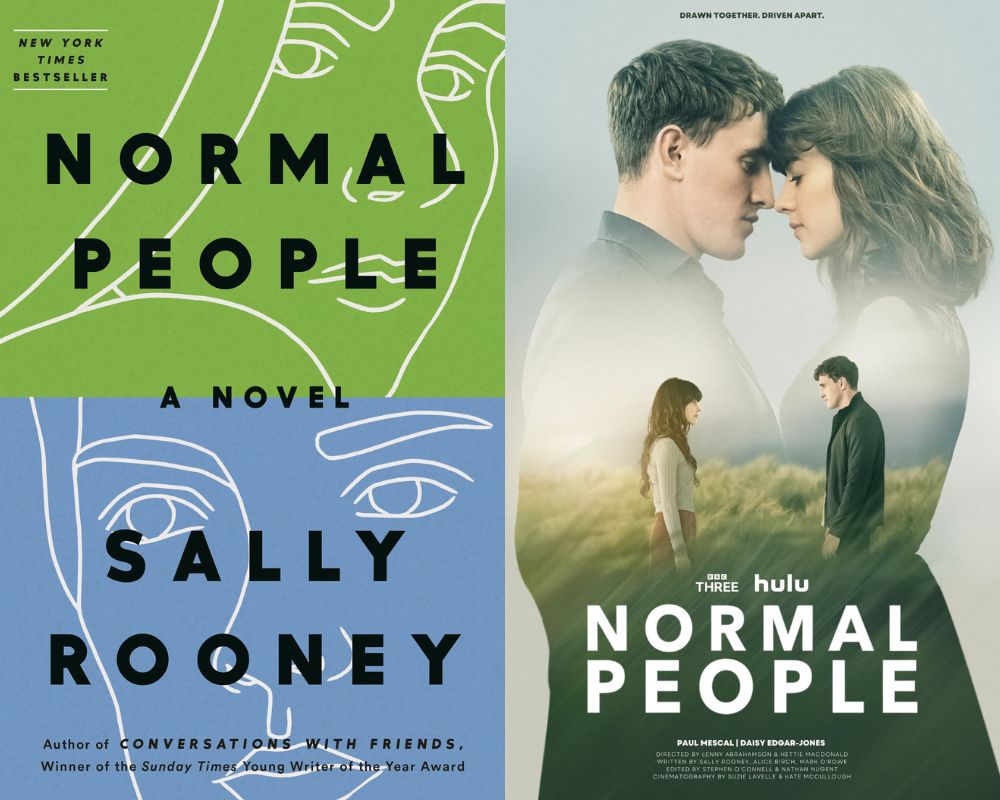
When Sally Rooney emerged on the modern literary scene, everyone collectively seemed to fall for her and her way of writing the complexities of interpersonal relationships. She did so first with Conversations With Friends, and then with Normal People, which really helped launch her into a more mainstream conversation. However, while Rooney’s subject matter is certainly topical for twentysomething readers in the best way possible, her writing itself tends to be somewhat meandering and cavalier, making it difficult to get through her books without stifling your annoyances.
This is where the TV adaptation of Normal People shines: it brings to life the brilliance of the novel’s plot, and it heightens all of the important things the novel wanted to say, yet everything feels heavier and weightier, which the book’s tone really needed. The show is absolutely dripping with feeling, even when the characters are attempting to seem cold, and the result is a story that’s so cathartic, it’s left me speechless in tears each time I’ve rewatched it. -Madeline Carpou
Foundation
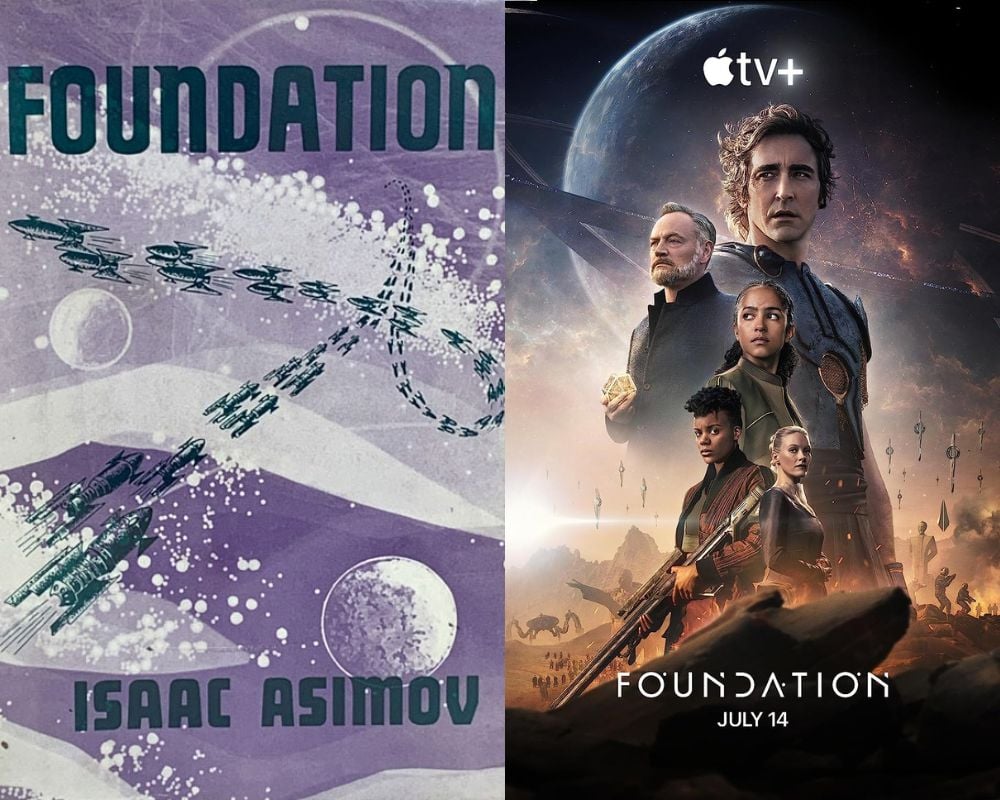
Isaac Asimov’s classic sci-fi series, Foundation, is a visionary thought experiment, exploring the ramifications of a mathematics system so advanced that it can predict the next several phases of human civilization. However, the series—which Asimov originally wrote as a series of short stories, instead of one cohesive narrative—hasn’t aged well. The dialogue is stilted. Much of the most important action happens off the page. And the first book of the series is an absolute failure when it comes to female characters.
Apple TV+’s adaption is a radical new approach to Asimov’s work, breathing new life into the series by rearranging the story and reimagining the characters. Hari Seldon goes from an all-knowing hologram to a flawed, invested character. Gaal Dornick gets to go on a centuries-long journey of discovery. And the Galactic Empire itself rivals the Star Wars universe in breadth and scope. With season 2 streaming now, this is an adaptation you don’t want to miss. –Julia Glassman
Bridgerton

Bridgerton is a series of eight Regency romance novels written by Julia Quinn that were published between 2000 and 2006. Each book focuses on a sibling from the Bridgerton family—Anthony, Benedict, Colin, Daphne, Eloise, Francesca, Gregory, and Hyacinth—as they navigate the London social scene to find their lifelong partners. The books were pretty well received when they first came out with some of them landing on The New York Times bestseller list and eventually they were turned into a Netflix series.
Now, while I haven’t read all of the books (mostly because they’re notoriously hard to find thanks to the Netflix show), the ones I had read are a bit … dull. In my opinion, the siblings don’t come off as charming or anyone you want to root for. Plus, the world as a whole feels pretty small as the books focus just on the siblings’ and their thoughts. The show, however, fleshes out the society they live in wonderfully as it focuses on the siblings’ friends, and enemies, and shows the inner workings of their beloveds’ lives. While the show is following the books’ formula of showcasing the love story of one sibling per season, it has gone out of the books’ order, which shakes up the dynamic between the characters we’ve come to know on the page. –Kayla Harrington
Y The Last Man

I don’t think I’ll ever get over the cancellation of Y: The Last Man by FX and Hulu. I’m a big fan of the comics, having read all ten volumes of the comic series for the first time in 2019 and owning the 3-inch thick omnibus. Still, the show knocked it out of the park. While the comics started strong and ended well, the middle proved complicated as the romances played out. Here, Brian K. Vaughan’s struggles writing women shone through (he has improved since)—which is terrible when nearly all cis-men on Earth died.
That brings me to my next point, which is the near-total exclusion of intersex, trans men, etc. from the conversation. It is a comic book, but it feels grounded in reality if and only if you stick with 5th-grade science. Not a great look when this gendercide story is for adults and nuanced in nearly every other way. The show recognized our biological sex diversity and included a trans man supporting character played by actual trans actors. This also expanded in the back end, as the show’s pool of writers and directors was largely made up of women and transgender creatives.
The adaptation shrunk the world physically by nixing the Israeli soldiers and Australian sections. However, it also expanded it by giving the supporting characters more of a story. Additionally, Y showed how people’s politics change over time rather than telling them just to get back to Yorrick Brown. Yorrick is fun and charming, but the least interesting aspect of the graphic novel (especially at the beginning). I’ll always treasure the story for getting me back in the comics. However, there’s no denying the massive improvements made to the show. The lost potential of its early cancellation will haunt me forever. –Alyssa Shotwell
The Queen’s Gambit

Walter Tevis’s terse, swift little novel The Queen’s Gambit is a great read, and it’s been enjoying a comeback ever since Netflix released its seven-episode adaptation. You know what the book doesn’t have, though? Anya Taylor-Joy. Joy brings her signature intensity and pathos to the role of the orphaned chess prodigy Elizabeth Harmon, as the series follows her from her childhood in an orphanage to her struggles with addiction and her eventual rise as a chess champion. –Julia Glassman
Mozart in the Jungle

Blair Tindall’s Mozart in the Jungle: Sex, Drugs, & Classical Music was a best-seller upon release, yet a very divisive one at that. While nobody could really say that her experiences in the NYC orchestral circuit were false, many found the book itself to be tedious and frustrating. Ultimately, since this was Tindall’s story being told, it was only natural that her own observations and judgments would take precedence, which did color some readers’ perceptions of the overall story she was trying to tell.
By contrast, the Amazon adaptation of Mozart in the Jungle is entirely its own story, and a fun one at that. While it does glamorize the life Tindall describes to a noticeable degree, it still paints the world of classical music as something none of us would expect—which is the point! These musicians are catty, slutty, and grimy while still managing to be fabulous! And it’s brilliant. Plus, the cast is utterly delightful, including Gael García Bernal as the maestro, Rodrigo de Souza. (And yes, my actor crush Peter Vack is in it as a dancer, so what.) -Madeline Carpou
Station Eleven

Station Eleven, Emily St. John-Mandel’s novel about a Shakespearean acting troupe eking out an existence after a deadly flu wipes out humanity, has its ups and downs. The post-apocalyptic scenes are gripping, and young actor Kirsten’s quest to find the second issue of an obscure comic book is a weirdly compelling storyline. However, the book also has some major flaws, with many of its pre-apocalypse scenes falling flat.
The 2021 miniseries on Max addresses many of those problems, adjusting storylines and strengthening connections between characters to give the series a more satisfying, cohesive feel than the book. Those changes gradually build up to a finale that will have you in tears. -Julia Glassman
Moon Girl and Devil Dinosaur
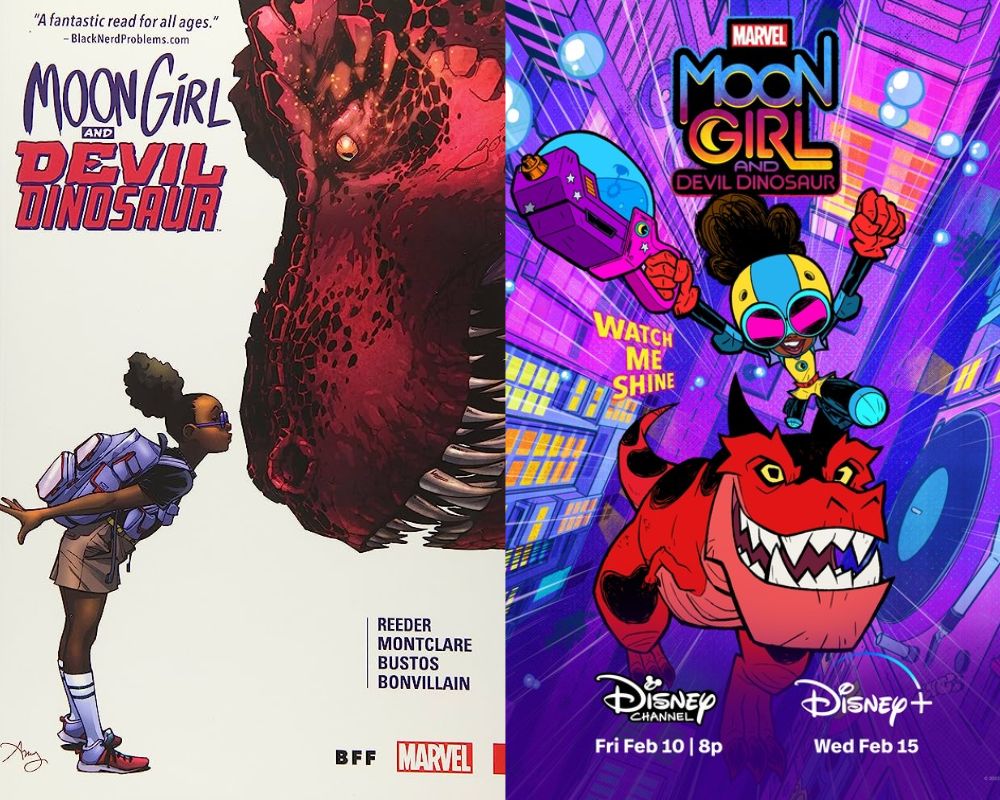
While the original run of Moon Girl and Devil Dinosaur, is cute and a great entry book for young comic-book readers, the Disney+ show is everything. The humor is multi-generational, and it features music, a.k.a. one of the hardest things to portray in comics. However, the main reason the show is a much better time is simply because it is Black AF.
In the comics, Lunella is obviously a Black child and her life is shaped by that experience. Still, the comic’s sole Black creative is its artist, Natacha Bustos. As an Afro-Latina in a very white country (Spain), Bustos sees many of the existing points of tension in her home as the U.S. and much of Latin America. Regardless, an artist can only do so much as the story will be mostly written when it reaches her.
The show, on the other hand, features a mostly Black cast who can make notes about the story and dialogue before the animation stage. Additionally, 1/3 of the creative team is Black, with the other 2/3rds made up of other people of color and white staff. A numbers game doesn’t make it more Black, but it makes things less one-dimensional and voyeuristic. As a Black viewer, I could tell that the story was for us and by us. Everyone should watch this and also read TMS‘ writer Julia Glassman’s great reviews! –Alyssa Shotwell
The Haunting of Hill House

The Haunting of Hill House is a ghostly book written by Shirley Jackson in 1959. The story follows four characters — Dr. John Montague, a supernatural investigator, Eleanor Vance, a woman who resents caring for her disabled mother, Theodora, an artist, and Luke Sanderson, the heir to Hill House, who hosts the group in his home. As the group spends the summer at Hill House, they all began to experience supernatural events like unseen noises, ghosts roaming the halls at night, and strange writing on the walls. Eventually, they discover the house is trying to possess Eleanor and try to flee before it takes hold of her for good.
While the book is haunting and terrifying in its own right, Mike Flannigan managed to take the story within Jackson’s book and turn it up about 1,000 notches. In The Haunting of Hill House, we follow the Crane family as both children and adults. The parents, Henry and Olivia, have moved into Hill House with their five children—Steven, Shirley, Luke, Theo, and Eleanor or “Nell”—for the summer as they try to repair the house so they can flip it. While living at the house, the children plus Olivia start to witness strange events in the house, much like the group in the book, which ends up leading to Olivia’s death.
Fast forward to the present day, the children are now adults and estranged from their father, who will not tell them about the events about their mother’s death. Nell, much like her book counterpart, suffers the most at the hands of the house as she’s constantly haunted by the “Broken Neck Lady.” But, unlike the book, the series explores a family’s grief and how the supernatural could be a manifestation of the ugly feelings inside all of us. The show manages to make you cry, laugh, and scream at the masterful jump scares sprinkled throughout the episodes. It’s truly one of the best book adaptations to date and proof that, if a creator understands the material, they can bring it to a whole new level. –Kayla Harrington
Sex And the City
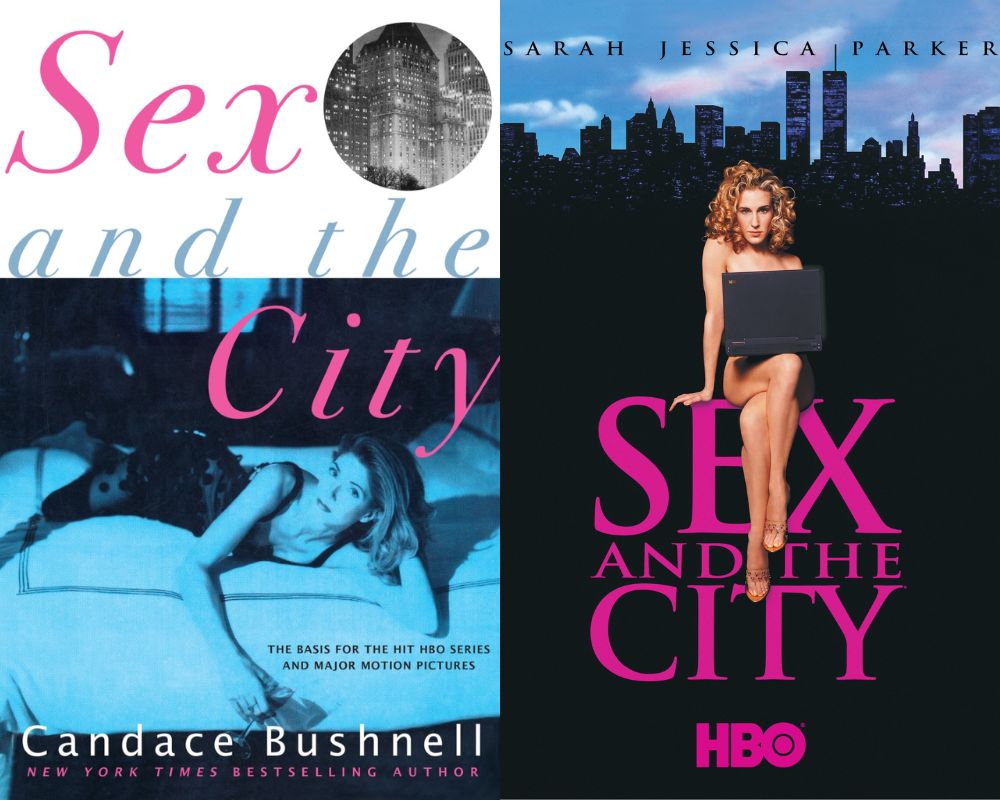
In the 1990s, New York Observer columnist Candace Bushnell achieved something many writers dream of: Her dating column, Sex in the City, was collected into a book, and that book went on to launch one of the most successful TV series of all time.
The book is … fine, but the series is where the world really fell in love with Carrie Bradshaw and her misadventures as a stylish single woman living it up in New York City. Whether you watch Sex in the City for the humor, the friendships, or the amazing outfits, you can’t deny that the series was a bigger phenomenon than the book could ever hope to be. (Too bad we can’t say the same about the revival, And Just Like That….) –Julia Glassman
Honorable mentions
Some shows aren’t straight adaptations and don’t feel like fair inclusions on this list. These are productions that are built on existing worlds from books. Works that may feature familiar characters but often occur at a different time. These adaptations we love equally to or more than the original text. Still, like straightforward adaptations, they couldn’t exist without the original story and imagination of the author. In many cases, they also couldn’t exist without the work of the artists that created the main adaptation, too.
- The Watchmen (2019)
- Interview with a Vampire
- Lord of the Rings: Rings of Power
- Orange is the New Black
—
What show did you like more than the book or source material? Let us know in the comments!
This piece was written during the 2023 WGA and SAG-AFTRA strikes. Without the labor of the writers and actors currently on strike, the work being covered here wouldn’t exist.
(Featured image: FX on Hulu and Netflix)



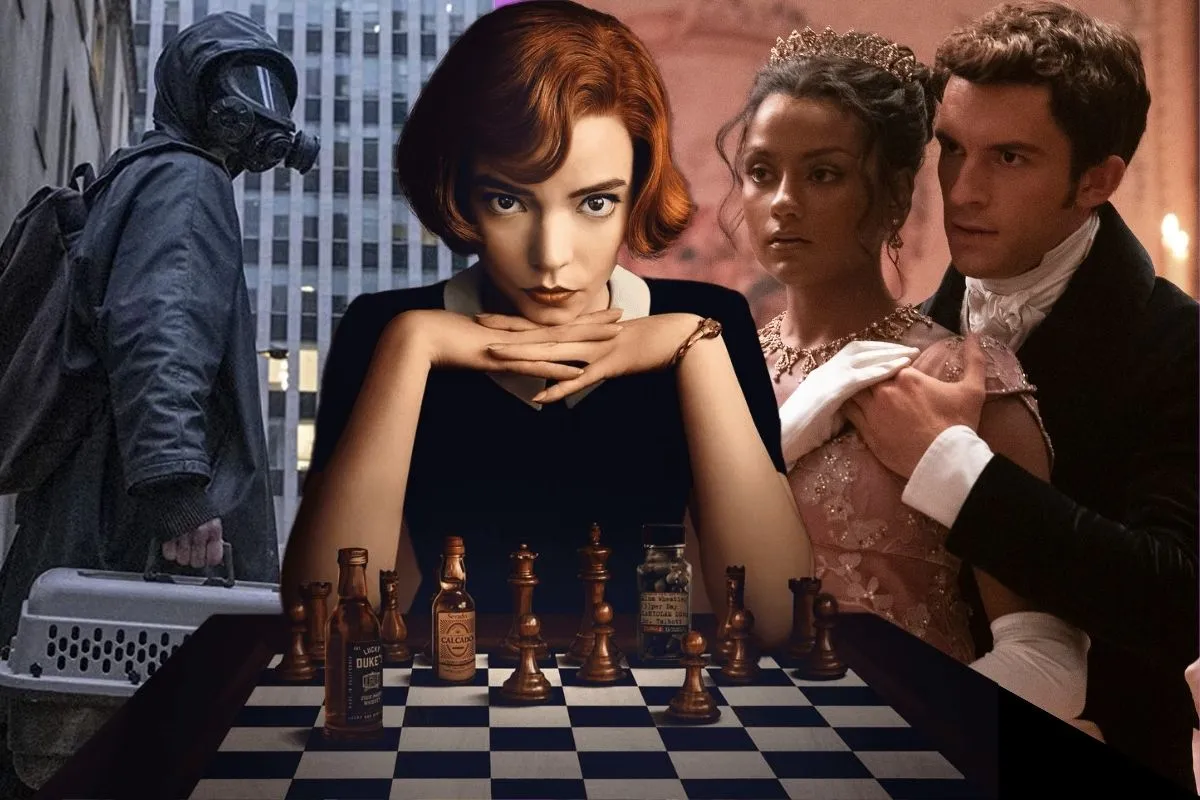









Published: Aug 11, 2023 01:57 pm